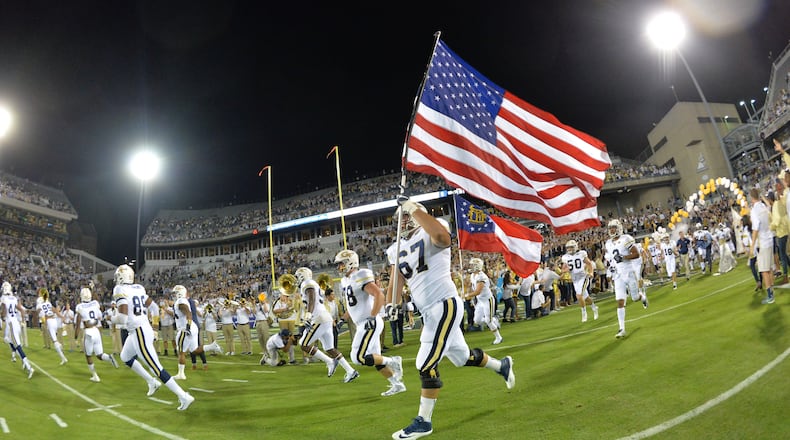Friday marked the 50th anniversary of a day in Georgia Tech athletic annals that isn’t celebrated and only vaguely remembered. On Jan. 24, 1964, the Institute announced its intent to leave the SEC. It’s a move that seems unthinkable today, when the SEC stands as the colossus of college football, and even then it was hard to fathom.
“It was a horrible decision,” said Mitchell Ginn, a Tech graduate in architecture and a Newnan residential designer who doubles as a historian. In 2011, Ginn reviewed the circumstances of Tech’s SEC secession and wrote a blow-by-blow account for the Georgia Tech Alumni Magazine. The article’s title: “The Day Georgia Tech Sports Changed Forever.”
Said Ginn: “People today probably don’t even know Georgia Tech was in the SEC. If they do, they assume they got out because they weren’t competitive.”
That wasn’t the case. As Ginn wrote: “Since 1951 (through 1963), Tech football was 6-3-1 versus Tennessee, 7-2-2 against Florida, 6-6-1 against Auburn, 7-6 against Alabama and 9-4 against state-rival Georgia. Tech football had been ranked in the top 20 each of these years and had won the national championship in 1952.”
At the crux of Tech’s exit was the so-called 140 Rule. SEC schools — there were 12, Tulane included — were allowed 140 scholarships for football and men’s basketball; football programs were allowed to sign as many 45 recruits per season. Tech coach Bobby Dodd believed that other teams were overrecruiting, pushing aside underperforming players to clear scholarship space for newer ones.
Said Taz Anderson, the Atlanta entrepreneur who was a captain under Dodd when the Yellow Jackets were based in the SEC: “Coach Dodd would not run you off if you met the part he required. If you went to class and did the work, he’d get you a degree.”
Said Bill Curry, who played under Dodd and would later coach at Tech: “That was an obsession with coach Dodd. I didn’t play very much my first two seasons. I was one of those he could have run off.”
Dodd wanted the SEC to allow fewer signees per recruiting class and had an ardent ally in Tech president Edwin Harrison. Tech almost got the 140 Rule changed at the 1963 SEC winter meetings, but Alabama president Frank Rose, breaking with the stated wishes of Crimson Tide coach Bear Bryant, voted to keep it.
That summer, The Atlanta Constitution ran a story proclaiming that Tech was prepared to leave the SEC over the 140 Rule. The 1964 meetings convened at the downtown Atlanta Americana Motor Hotel, with some believing that the Jackets had delivered an ultimatum: Change the rule or we’re out.
Said Ginn: “(Dodd) really felt confident in ’64 that he had the votes. But a lot of people got their feelings hurt and felt it was a do-or-die issue. Tech people made up their minds they were going to leave if they didn’t have a vote to change, but they thought they’d get the votes.”
After two days of wrangling and failed compromises, Harrison opened the Friday presidents’ meeting by saying, “Georgia Tech’s interests would best be served by withdrawing from the conference.” As Ginn noted in his article, the official vote had not yet been taken. When it was, the count was 11-0 to keep the 140 Rule.
Word of Tech’s departure hit like a thunderclap. “Tech was something of the Southern regional school,” Ginn said, “something of an elitist school. It was a little like Notre Dame. A lot of people (meaning national sports writers) would rather fly into Atlanta than muck it over to Auburn or Alabama. As big as the SEC was, it was still seen as a rural thing.”
Tech was the exception — a technical institute among mostly state universities — and the belief among other SEC schools was that Tech deemed itself exceptional. Ole Miss and Mississippi State disliked Dodd because he refused to schedule them. Auburn so loathed the Jackets that it held an annual “Wreck Tech” parade. Relations between Dodd and Bryant grew chilly after Tech player Chick Graning had his jaw broken (and career ended) by an egregious Alabama elbow in 1961.
The Jackets were seen as an aloof outlier in a conference they had, in 1932, helped found. This led some to suggest that Dodd was eager for Tech to become an independent. But Curry, who was a Tech junior when the Jackets left the SEC, said: “Coach Dodd met with us afterward and told us it was about that rule. It wasn’t just a moral thing. Coach Dodd believed he was being put at a competitive disadvantage (because others would oversign and Tech refused).”
Tech’s first few seasons without conference affiliation weren’t awful: It went 7-3-1 and won the Gator Bowl in 1965 and was 9-2, losing to Florida in the Orange Bowl, in 1966. Dodd would resign as coach before the 1967 season because of health issues. He remained Tech’s athletic director until 1976.
Wrote Ginn: “The years that followed as an independent were mostly lean ones. From 1964 to 1982, Georgia Tech’s football record was 104-100-5. Compare that to Tech’s … record of 206-110-12 from 1933 to 1963. As an independent, Georgia Tech saw its facilities become worn and outdated, surpassed in size and quality by most of its Southern competitors.”
Said Anderson: “We lost some great rivalries we had. We played Alabama and Auburn. We played LSU — that was a great rivalry. Tennessee was a big rivalry because of coach Dodd (who played quarterback there under Gen. Robert Neyland). People really enjoyed those. It has taken a long time for that to heal.
“But now that we’ve been in ACC for a while, that’s kind of calmed over. We realize we’ve got some relationships that are pretty good relationships, games that are very competitive.”
Tech began playing football in the ACC in 1983 under Curry, ending 19 seasons as an independent. Anderson believes that his alma mater is more suited to the more genteel ACC than it would have been to the bigger and brawnier SEC. “We’re in a conference now that most people believe has some real focus on academics,” he said.
Said Curry: “I don’t know if that’s true. I don’t know if the ACC is a better fit. We’ve said we’re not going to use academics as an excuse.”
One consequence of Tech’s SEC exit that Curry will concede involves Atlanta itself. He grew up in College Park rooting for the Bulldogs, his father having been a Georgia graduate. In Curry’s mind, the city was split almost 50-50 between Jackets and Bulldogs in the early ’60s, but this remained an SEC town even without an SEC team. By leaving the conference, Tech ceded Atlanta to Georgia.
Wrote Ginn: “Arguably, the level of national prestige that Tech football enjoyed as a member in the SEC has never returned. … In 1963, the enrollment at Georgia Tech was about 6,300 students, and there were roughly 50,000 living alumni. In 2011, the enrollment at Georgia Tech (was) more than 20,000, and there (were) more than 120,000 living alumni. Atlanta’s metro population more than tripled. Yet Georgia Tech’s average football attendance for 2010 was less than in 1963.”
Many schools today would move heaven and earth for the chance to join the SEC — indeed, Texas A&M burned every Big 12 bridge to put itself in that position — but Tech, a charter member, left after a disagreement over a single rule that, viewed through the prism of history, wouldn’t have seemed a deal-breaker.
“It’s hard to know what would have happened if Tech had never left,” Ginn said, but he took a guess: “If they were still in the SEC, they’d be having sold-out games constantly. … I appreciate and understand the past. I realize decisions were made and you can’t go back. But if (Tech people) had known the outcome, they probably wouldn’t have gone down that road.”
About the Author
Keep Reading
The Latest
Featured



